window CADILLAC XT5 2020 Repair Manual
[x] Cancel search | Manufacturer: CADILLAC, Model Year: 2020, Model line: XT5, Model: CADILLAC XT5 2020Pages: 384, PDF Size: 6.52 MB
Page 307 of 384
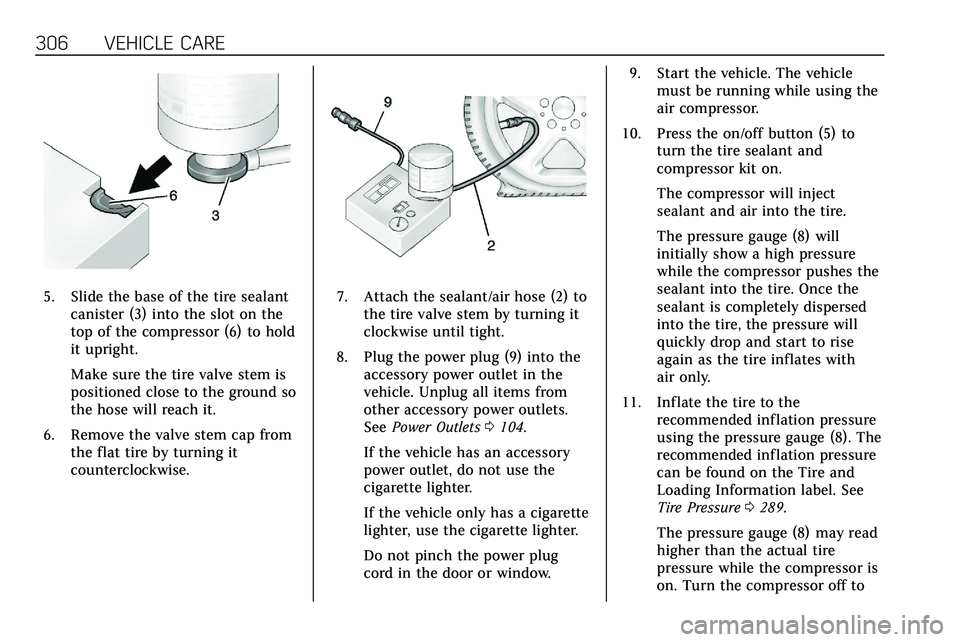
306 VEHICLE CARE
5. Slide the base of the tire sealantcanister (3) into the slot on the
top of the compressor (6) to hold
it upright.
Make sure the tire valve stem is
positioned close to the ground so
the hose will reach it.
6. Remove the valve stem cap from the flat tire by turning it
counterclockwise.7. Attach the sealant/air hose (2) tothe tire valve stem by turning it
clockwise until tight.
8. Plug the power plug (9) into the accessory power outlet in the
vehicle. Unplug all items from
other accessory power outlets.
See Power Outlets 0104.
If the vehicle has an accessory
power outlet, do not use the
cigarette lighter.
If the vehicle only has a cigarette
lighter, use the cigarette lighter.
Do not pinch the power plug
cord in the door or window. 9. Start the vehicle. The vehicle
must be running while using the
air compressor.
10. Press the on/off button (5) to turn the tire sealant and
compressor kit on.
The compressor will inject
sealant and air into the tire.
The pressure gauge (8) will
initially show a high pressure
while the compressor pushes the
sealant into the tire. Once the
sealant is completely dispersed
into the tire, the pressure will
quickly drop and start to rise
again as the tire inflates with
air only.
11. Inflate the tire to the recommended inflation pressure
using the pressure gauge (8). The
recommended inflation pressure
can be found on the Tire and
Loading Information label. See
Tire Pressure 0289.
The pressure gauge (8) may read
higher than the actual tire
pressure while the compressor is
on. Turn the compressor off to
Page 310 of 384
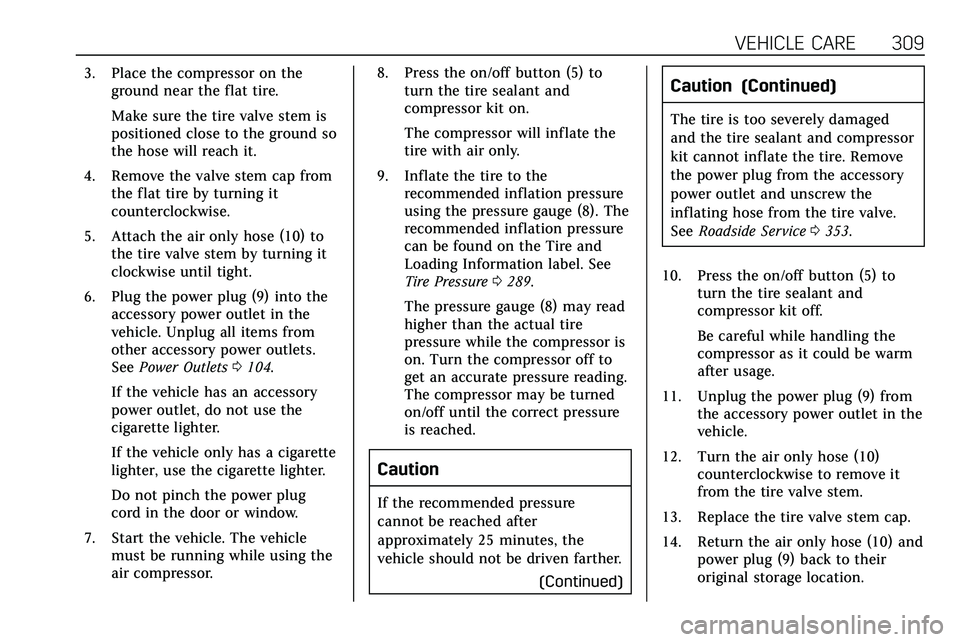
VEHICLE CARE 309
3. Place the compressor on theground near the flat tire.
Make sure the tire valve stem is
positioned close to the ground so
the hose will reach it.
4. Remove the valve stem cap from the flat tire by turning it
counterclockwise.
5. Attach the air only hose (10) to the tire valve stem by turning it
clockwise until tight.
6. Plug the power plug (9) into the accessory power outlet in the
vehicle. Unplug all items from
other accessory power outlets.
See Power Outlets 0104.
If the vehicle has an accessory
power outlet, do not use the
cigarette lighter.
If the vehicle only has a cigarette
lighter, use the cigarette lighter.
Do not pinch the power plug
cord in the door or window.
7. Start the vehicle. The vehicle must be running while using the
air compressor. 8. Press the on/off button (5) to
turn the tire sealant and
compressor kit on.
The compressor will inflate the
tire with air only.
9. Inflate the tire to the recommended inflation pressure
using the pressure gauge (8). The
recommended inflation pressure
can be found on the Tire and
Loading Information label. See
Tire Pressure 0289.
The pressure gauge (8) may read
higher than the actual tire
pressure while the compressor is
on. Turn the compressor off to
get an accurate pressure reading.
The compressor may be turned
on/off until the correct pressure
is reached.
Caution
If the recommended pressure
cannot be reached after
approximately 25 minutes, the
vehicle should not be driven farther. (Continued)
Caution (Continued)
The tire is too severely damaged
and the tire sealant and compressor
kit cannot inflate the tire. Remove
the power plug from the accessory
power outlet and unscrew the
inflating hose from the tire valve.
SeeRoadside Service 0353.
10. Press the on/off button (5) to turn the tire sealant and
compressor kit off.
Be careful while handling the
compressor as it could be warm
after usage.
11. Unplug the power plug (9) from the accessory power outlet in the
vehicle.
12. Turn the air only hose (10) counterclockwise to remove it
from the tire valve stem.
13. Replace the tire valve stem cap.
14. Return the air only hose (10) and power plug (9) back to their
original storage location.
Page 324 of 384

VEHICLE CARE 323
Appearance Care
Exterior Care
Locks
Locks are lubricated at the factory.
Use a de-icing agent only when
absolutely necessary, and have the
locks greased after using. See
Recommended Fluids and Lubricants
0342.
Washing the Vehicle
To preserve the vehicle's finish, wash
it often and out of direct sunlight.
Caution
Do not use petroleum-based, acidic,
or abrasive cleaning agents as they
can damage the vehicle's paint,
metal, or plastic parts. If damage
occurs, it would not be covered by
the vehicle warranty. Approved
cleaning products can be obtained
from your dealer. Follow all
manufacturer directions regarding
(Continued)
Caution (Continued)
correct product usage, necessary
safety precautions, and appropriate
disposal of any vehicle care
product.
Caution
Avoid using high-pressure washes
closer than 30 cm (12 in) to the
surface of the vehicle. Use of power
washers exceeding 8 274 kPa
(1,200 psi) can result in damage or
removal of paint and decals.
Caution
Do not power wash any component
under the hood that has this
e
symbol.
This could cause damage that
would not be covered by the vehicle
warranty. If using an automatic car wash, follow
the car wash instructions. The
windshield wiper and rear window
wiper, if equipped, must be off.
Remove any accessories that may be
damaged or interfere with the car
wash equipment.
Rinse the vehicle well, before washing
and after, to remove all cleaning
agents completely. If they are allowed
to dry on the surface, they could stain.
Dry the finish with a soft, clean
chamois or an all-cotton towel to
avoid surface scratches and water
spotting.
Finish Care
Application of aftermarket clearcoat
sealant/wax materials is not
recommended. If painted surfaces are
damaged, see your dealer to have the
damage assessed and repaired. Foreign
materials such as calcium chloride
and other salts, ice melting agents,
road oil and tar, tree sap, bird
droppings, chemicals from industrial
chimneys, etc., can damage the
vehicle's finish if they remain on
painted surfaces. Wash the vehicle as
Page 328 of 384

VEHICLE CARE 327
the fluid. Contaminated fluid will
decrease the life of the transfer case
and/or axles and should be replaced.
Sheet Metal Damage
If the vehicle is damaged and requires
sheet metal repair or replacement,
make sure the body repair shop
applies anti-corrosion material to
parts repaired or replaced to restore
corrosion protection.
Original manufacturer replacement
parts will provide the corrosion
protection while maintaining the
vehicle warranty.
Finish Damage
Quickly repair minor chips and
scratches with touch-up materials
available from your dealer to avoid
corrosion. Larger areas of finish
damage can be corrected in your
dealer's body and paint shop.
Chemical Paint Spotting
Airborne pollutants can fall upon and
attack painted vehicle surfaces
causing blotchy, ring-shaped
discolorations, and small, irregulardark spots etched into the paint
surface. See
“Finish Care”previously in
this section.
Interior Care
To prevent dirt particle abrasions,
regularly clean the vehicle's interior.
Immediately remove any soils.
Newspapers or dark garments can
transfer color to the vehicle’s interior.
Use a soft bristle brush to remove
dust from knobs and crevices on the
instrument cluster. Using a mild soap
solution, immediately remove hand
lotions, sunscreen, and insect
repellent from all interior surfaces or
permanent damage may result.
Use cleaners specifically designed for
the surfaces being cleaned to prevent
permanent damage. Apply all cleaners
directly to the cleaning cloth. Do not
spray cleaners on any switches or
controls. Remove cleaners quickly.
Before using cleaners, read and follow
all safety instructions on the label.
While cleaning the interior, open the
doors and windows to get proper
ventilation. To prevent damage, do not clean the
interior using the following cleaners
or techniques:
.
Never use a razor or any other
sharp object to remove soil from
any interior surface.
. Never use a brush with stiff
bristles.
. Never rub any surface aggressively
or with too much pressure.
. Do not use laundry detergents or
dishwashing soaps with
degreasers. For liquid cleaners, use
approximately 20 drops per 3.8 L
(1 gal) of water. A concentrated
soap solution will create streaks
and attract dirt. Do not use
solutions that contain strong or
caustic soap.
. Do not heavily saturate the
upholstery when cleaning.
. Do not use solvents or cleaners
containing solvents.
Page 329 of 384

328 VEHICLE CARE
Interior Glass
To clean, use a terry cloth fabric
dampened with water. Wipe droplets
left behind with a clean dry cloth.
If necessary, use a commercial glass
cleaner after cleaning with plain water.
Caution
To prevent scratching, never use
abrasive cleaners on automotive
glass. Abrasive cleaners or
aggressive cleaning may damage
the rear window defogger.
Cleaning the windshield with water
during the first three to six months of
ownership will reduce tendency to fog.
Speaker Covers
Vacuum around a speaker cover
gently, so that the speaker will not be
damaged. Clean spots with water and
mild soap.
Coated Moldings
Coated moldings should be cleaned. .
When lightly soiled, wipe with a
sponge or soft, lint-free cloth
dampened with water.
. When heavily soiled, use warm
soapy water.
Fabric/Carpet/Suede
Start by vacuuming the surface using
a soft brush attachment. If a rotating
vacuum brush attachment is being
used, only use it on the floor carpet.
Before cleaning, gently remove as
much of the soil as possible:
.Gently blot liquids with a paper
towel. Continue blotting until no
more soil can be removed.
. For solid soils, remove as much as
possible prior to vacuuming.
To clean: 1. Saturate a clean, lint-free colorfast cloth with water.
Microfiber cloth is recommended
to prevent lint transfer to the
fabric or carpet.
2. Remove excess moisture by gently wringing until water does
not drip from the cleaning cloth. 3. Start on the outside edge of the
soil and gently rub toward the
center. Fold the cleaning cloth to
a clean area frequently to
prevent forcing the soil in to the
fabric.
4. Continue gently rubbing the soiled area until there is no
longer any color transfer from
the soil to the cleaning cloth.
5. If the soil is not completely removed, use a mild soap
solution followed only by plain
water.
If the soil is not completely removed,
it may be necessary to use a
commercial upholstery cleaner or spot
lifter. Test a small hidden area for
colorfastness before using a
commercial upholstery cleaner or spot
lifter. If ring formation occurs, clean
the entire fabric or carpet.
After cleaning, use a paper towel to
blot excess moisture.
Page 330 of 384

VEHICLE CARE 329
Cleaning High Gloss Surfaces
and Vehicle Information and
Radio Displays
Use a microfiber cloth on high gloss
surfaces or vehicle displays. First, use
a soft bristle brush to remove dirt that
can scratch the surface. Then gently
clean by rubbing with a microfiber
cloth. Never use window cleaners or
solvents. Periodically hand wash the
microfiber cloth separately, using mild
soap. Do not use bleach or fabric
softener. Rinse thoroughly and air dry
before next use.
Caution
Do not attach a device with a
suction cup to the display. This may
cause damage and would not be
covered by the vehicle warranty.
Instrument Panel, Leather, Vinyl,
Other Plastic Surfaces, Low
Gloss Paint Surfaces, and
Natural Open Pore Wood
Surfaces
Use a soft microfiber cloth dampened
with water to remove dust and loose
dirt. For a more thorough cleaning,
use a soft microfiber cloth dampened
with a mild soap solution.
Caution
Soaking or saturating leather,
especially perforated leather, as well
as other interior surfaces, may
cause permanent damage. Wipe
excess moisture from these surfaces
after cleaning and allow them to
dry naturally. Never use heat,
steam, or spot removers. Do not use
cleaners that contain silicone or
wax-based products. Cleaners
containing these solvents can
permanently change the appearance
and feel of leather or soft trim, and
are not recommended.Do not use cleaners that increase
gloss, especially on the instrument
panel. Reflected glare can decrease
visibility through the windshield
under certain conditions.
Caution
Use of air fresheners may cause
permanent damage to plastics and
painted surfaces. If an air freshener
comes in contact with any plastic
or painted surface in the vehicle,
blot immediately and clean with a
soft cloth dampened with a mild
soap solution. Damage caused by
air fresheners would not be covered
by the vehicle warranty.
Cargo Cover and
Convenience Net
If equipped, wash with warm water
and mild detergent. Do not use
chlorine bleach. Rinse with cold water,
and then dry completely.
Care of Seat Belts
Keep belts clean and dry.
Page 337 of 384
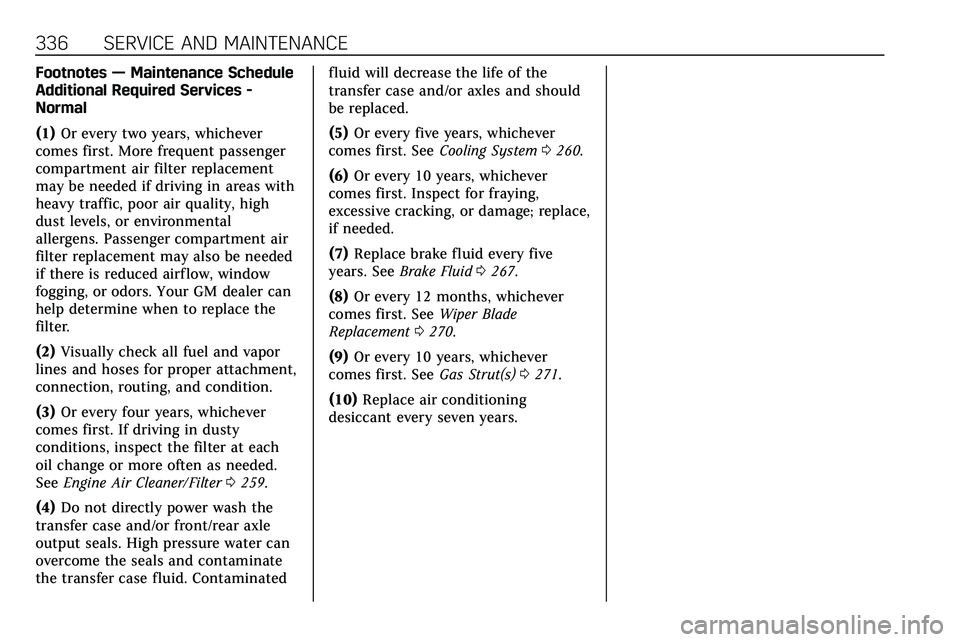
336 SERVICE AND MAINTENANCE
Footnotes—Maintenance Schedule
Additional Required Services -
Normal
(1) Or every two years, whichever
comes first. More frequent passenger
compartment air filter replacement
may be needed if driving in areas with
heavy traffic, poor air quality, high
dust levels, or environmental
allergens. Passenger compartment air
filter replacement may also be needed
if there is reduced airf low, window
fogging, or odors. Your GM dealer can
help determine when to replace the
filter.
(2) Visually check all fuel and vapor
lines and hoses for proper attachment,
connection, routing, and condition.
(3) Or every four years, whichever
comes first. If driving in dusty
conditions, inspect the filter at each
oil change or more often as needed.
See Engine Air Cleaner/Filter 0259.
(4) Do not directly power wash the
transfer case and/or front/rear axle
output seals. High pressure water can
overcome the seals and contaminate
the transfer case fluid. Contaminated fluid will decrease the life of the
transfer case and/or axles and should
be replaced.
(5)
Or every five years, whichever
comes first. See Cooling System0260.
(6) Or every 10 years, whichever
comes first. Inspect for fraying,
excessive cracking, or damage; replace,
if needed.
(7) Replace brake fluid every five
years. See Brake Fluid 0267.
(8) Or every 12 months, whichever
comes first. See Wiper Blade
Replacement 0270.
(9) Or every 10 years, whichever
comes first. See Gas Strut(s)0271.
(10) Replace air conditioning
desiccant every seven years.
Page 339 of 384
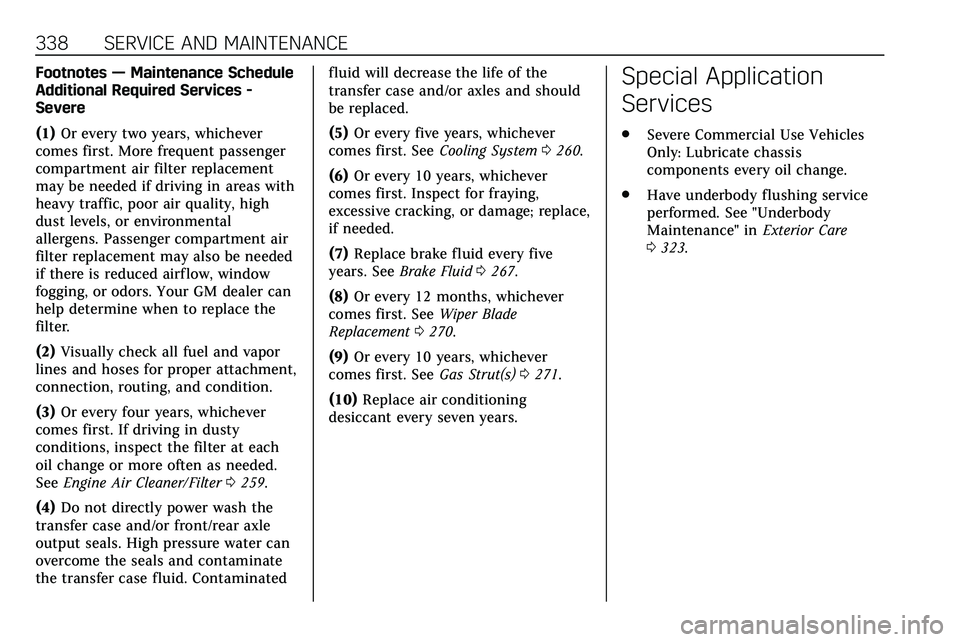
338 SERVICE AND MAINTENANCE
Footnotes—Maintenance Schedule
Additional Required Services -
Severe
(1) Or every two years, whichever
comes first. More frequent passenger
compartment air filter replacement
may be needed if driving in areas with
heavy traffic, poor air quality, high
dust levels, or environmental
allergens. Passenger compartment air
filter replacement may also be needed
if there is reduced airf low, window
fogging, or odors. Your GM dealer can
help determine when to replace the
filter.
(2) Visually check all fuel and vapor
lines and hoses for proper attachment,
connection, routing, and condition.
(3) Or every four years, whichever
comes first. If driving in dusty
conditions, inspect the filter at each
oil change or more often as needed.
See Engine Air Cleaner/Filter 0259.
(4) Do not directly power wash the
transfer case and/or front/rear axle
output seals. High pressure water can
overcome the seals and contaminate
the transfer case fluid. Contaminated fluid will decrease the life of the
transfer case and/or axles and should
be replaced.
(5)
Or every five years, whichever
comes first. See Cooling System0260.
(6) Or every 10 years, whichever
comes first. Inspect for fraying,
excessive cracking, or damage; replace,
if needed.
(7) Replace brake fluid every five
years. See Brake Fluid 0267.
(8) Or every 12 months, whichever
comes first. See Wiper Blade
Replacement 0270.
(9) Or every 10 years, whichever
comes first. See Gas Strut(s)0271.
(10) Replace air conditioning
desiccant every seven years.Special Application
Services
. Severe Commercial Use Vehicles
Only: Lubricate chassis
components every oil change.
. Have underbody flushing service
performed. See "Underbody
Maintenance" in Exterior Care
0 323.
Page 380 of 384
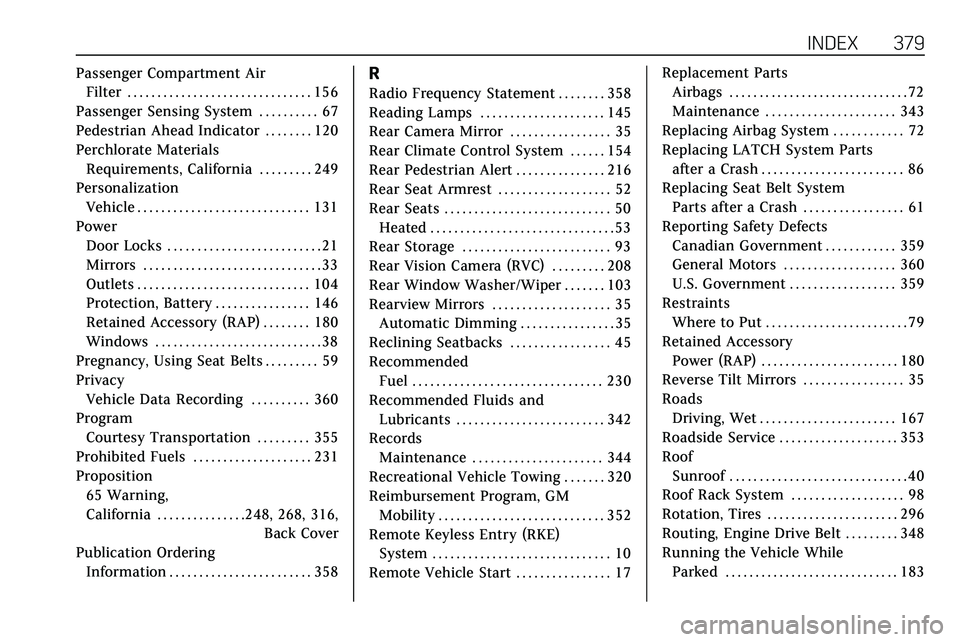
INDEX 379
Passenger Compartment AirFilter . . . . . . . . . . . . . . . . . . . . . . . . . . . . . . . 156
Passenger Sensing System . . . . . . . . . . 67
Pedestrian Ahead Indicator . . . . . . . . 120
Perchlorate Materials Requirements, California . . . . . . . . . 249
Personalization
Vehicle . . . . . . . . . . . . . . . . . . . . . . . . . . . . . 131
Power Door Locks . . . . . . . . . . . . . . . . . . . . . . . . . . 21
Mirrors . . . . . . . . . . . . . . . . . . . . . . . . . . . . . . 33
Outlets . . . . . . . . . . . . . . . . . . . . . . . . . . . . . 104
Protection, Battery . . . . . . . . . . . . . . . . 146
Retained Accessory (RAP) . . . . . . . . 180
Windows . . . . . . . . . . . . . . . . . . . . . . . . . . . . 38
Pregnancy, Using Seat Belts . . . . . . . . . 59
Privacy
Vehicle Data Recording . . . . . . . . . . 360
Program Courtesy Transportation . . . . . . . . . 355
Prohibited Fuels . . . . . . . . . . . . . . . . . . . . 231
Proposition
65 Warning,
California . . . . . . . . . . . . . . .248, 268, 316, Back Cover
Publication Ordering Information . . . . . . . . . . . . . . . . . . . . . . . . 358R
Radio Frequency Statement . . . . . . . . 358
Reading Lamps . . . . . . . . . . . . . . . . . . . . . 145
Rear Camera Mirror . . . . . . . . . . . . . . . . . 35
Rear Climate Control System . . . . . . 154
Rear Pedestrian Alert . . . . . . . . . . . . . . . 216
Rear Seat Armrest . . . . . . . . . . . . . . . . . . . 52
Rear Seats . . . . . . . . . . . . . . . . . . . . . . . . . . . . 50Heated . . . . . . . . . . . . . . . . . . . . . . . . . . . . . . . 53
Rear Storage . . . . . . . . . . . . . . . . . . . . . . . . . 93
Rear Vision Camera (RVC) . . . . . . . . . 208
Rear Window Washer/Wiper . . . . . . . 103
Rearview Mirrors . . . . . . . . . . . . . . . . . . . . 35 Automatic Dimming . . . . . . . . . . . . . . . . 35
Reclining Seatbacks . . . . . . . . . . . . . . . . . 45
Recommended Fuel . . . . . . . . . . . . . . . . . . . . . . . . . . . . . . . . 230
Recommended Fluids and Lubricants . . . . . . . . . . . . . . . . . . . . . . . . . 342
Records Maintenance . . . . . . . . . . . . . . . . . . . . . . 344
Recreational Vehicle Towing . . . . . . . 320
Reimbursement Program, GM Mobility . . . . . . . . . . . . . . . . . . . . . . . . . . . . 352
Remote Keyless Entry (RKE) System . . . . . . . . . . . . . . . . . . . . . . . . . . . . . . 10
Remote Vehicle Start . . . . . . . . . . . . . . . . 17 Replacement Parts
Airbags . . . . . . . . . . . . . . . . . . . . . . . . . . . . . . 72
Maintenance . . . . . . . . . . . . . . . . . . . . . . 343
Replacing Airbag System . . . . . . . . . . . . 72
Replacing LATCH System Parts after a Crash . . . . . . . . . . . . . . . . . . . . . . . . 86
Replacing Seat Belt System
Parts after a Crash . . . . . . . . . . . . . . . . . 61
Reporting Safety Defects Canadian Government . . . . . . . . . . . . 359
General Motors . . . . . . . . . . . . . . . . . . . 360
U.S. Government . . . . . . . . . . . . . . . . . . 359
Restraints Where to Put . . . . . . . . . . . . . . . . . . . . . . . . 79
Retained Accessory Power (RAP) . . . . . . . . . . . . . . . . . . . . . . . 180
Reverse Tilt Mirrors . . . . . . . . . . . . . . . . . 35
Roads Driving, Wet . . . . . . . . . . . . . . . . . . . . . . . 167
Roadside Service . . . . . . . . . . . . . . . . . . . . 353
Roof Sunroof . . . . . . . . . . . . . . . . . . . . . . . . . . . . . . 40
Roof Rack System . . . . . . . . . . . . . . . . . . . 98
Rotation, Tires . . . . . . . . . . . . . . . . . . . . . . 296
Routing, Engine Drive Belt . . . . . . . . . 348
Running the Vehicle While Parked . . . . . . . . . . . . . . . . . . . . . . . . . . . . . 183
Page 383 of 384

382 INDEX
V
VehicleAlarm System . . . . . . . . . . . . . . . . . . . . . . . 30
Canadian Owners . . . . . . . . . . . . . . . . . . . . 2
Control . . . . . . . . . . . . . . . . . . . . . . . . . . . . 160
Identification Number (VIN) . . . . . 345
Load Limits . . . . . . . . . . . . . . . . . . . . . . . 170
Messages . . . . . . . . . . . . . . . . . . . . . . . . . . 130
Personalization . . . . . . . . . . . . . . . . . . . 131
Remote Start . . . . . . . . . . . . . . . . . . . . . . . . 17
Security . . . . . . . . . . . . . . . . . . . . . . . . . . . . . . 30
Speed Messages . . . . . . . . . . . . . . . . . . . 131
Towing . . . . . . . . . . . . . . . . . . . . . . . . . . . . 319
Vehicle Ahead Indicator . . . . . . . . . . . . 119
Vehicle Care
Storing the Tire Sealant andCompressor Kit . . . . . . . . . . . . . . . . . . 310
Tire Pressure . . . . . . . . . . . . . . . . . . . . . . 289
Vehicle Data Recording and
Privacy . . . . . . . . . . . . . . . . . . . . . . . . . . . . . 360
Vehicle Security Steering Column Lock . . . . . . . . . . . . . . 31
Ventilation, Air . . . . . . . . . . . . . . . . . . . . . 156
Visors . . . . . . . . . . . . . . . . . . . . . . . . . . . . . . . . . 40
W
Warning Brake System Light . . . . . . . . . . . . . . . 117 Warning (cont'd)
Caution and Danger . . . . . . . . . . . . . . . . . 2
Warning Lights, Gauges, and Indicators . . . . . . . . . . . . . . . . . . . . . . . . . . 107
Warnings Hazard Flashers . . . . . . . . . . . . . . . . . . . 143
Washer Fluid . . . . . . . . . . . . . . . . . . . . . . . . 266
Wheels
Alignment and Tire Balance . . . . . 300
Different Size . . . . . . . . . . . . . . . . . . . . . . 299
Replacement . . . . . . . . . . . . . . . . . . . . . . 301
When It Is Time for New Tires . . . . 297
Where to Put the Restraint . . . . . . . . . 79
Windows . . . . . . . . . . . . . . . . . . . . . . . . . . . . . 38
Power . . . . . . . . . . . . . . . . . . . . . . . . . . . . . . . . 38
Windshield
Replacement . . . . . . . . . . . . . . . . . . . . . . 271
Wiper/Washer . . . . . . . . . . . . . . . . . . . . . 101
Winter Driving . . . . . . . . . . . . . . . . . . . . . . . . . . . . 168
Winter Tires . . . . . . . . . . . . . . . . . . . . . . . . . 283
Wiper Blade Replacement . . . . . . . . . . 270
Wipers
Rear Washer . . . . . . . . . . . . . . . . . . . . . . 103
Wireless Charging . . . . . . . . . . . . . . . . . . 105